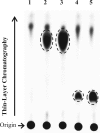Sulfation of ractopamine and salbutamol by the human cytosolic sulfotransferases
- PMID: 22763752
- PMCID: PMC3529569
- DOI: 10.1093/jb/mvs073
Sulfation of ractopamine and salbutamol by the human cytosolic sulfotransferases
Abstract
Feed additives such as ractopamine and salbutamol are pharmacologically active compounds, acting primarily as β-adrenergic agonists. This study was designed to investigate whether the sulfation of ractopamine and salbutamol may occur under the metabolic conditions and to identify the human cytosolic sulfotransferases (SULTs) that are capable of sulfating two major feed additive compounds, ractopamine and salbutamol. A metabolic labelling study showed the generation and release of [(35)S]sulfated ractopamine and salbutamol by HepG2 human hepatoma cells labelled with [(35)S]sulfate in the presence of these two compounds. A systematic analysis using 11 purified human SULTs revealed SULT1A3 as the major SULT responsible for the sulfation of ractopamine and salbutamol. The pH dependence and kinetic parameters were analyzed. Moreover, the inhibitory effects of ractopamine and salbutamol on SULT1A3-mediated dopamine sulfation were investigated. Cytosol or S9 fractions of human lung, liver, kidney and small intestine were examined to verify the presence of ractopamine-/salbutamol-sulfating activity in vivo. Of the four human organs, the small intestine displayed the highest activity towards both compounds. Collectively, these results imply that the sulfation mediated by SULT1A3 may play an important role in the metabolism and detoxification of ractopamine and salbutamol.
Figures






Similar articles
-
Sulfation of phenylephrine by the human cytosolic sulfotransferases.Drug Metab Lett. 2014;8(2):96-100. doi: 10.2174/1872312808666141127113715. Drug Metab Lett. 2014. PMID: 25429512
-
Sulfation of opioid drugs by human cytosolic sulfotransferases: metabolic labeling study and enzymatic analysis.Eur J Pharm Sci. 2014 Oct 1;62:40-8. doi: 10.1016/j.ejps.2014.05.003. Epub 2014 May 14. Eur J Pharm Sci. 2014. PMID: 24832963 Free PMC article.
-
On the sulfation of O-desmethyltramadol by human cytosolic sulfotransferases.Pharmacol Rep. 2017 Oct;69(5):953-958. doi: 10.1016/j.pharep.2017.02.014. Epub 2017 Feb 16. Pharmacol Rep. 2017. PMID: 28802998
-
Updated perspectives on the cytosolic sulfotransferases (SULTs) and SULT-mediated sulfation.Biosci Biotechnol Biochem. 2017 Jan;81(1):63-72. doi: 10.1080/09168451.2016.1222266. Epub 2016 Sep 21. Biosci Biotechnol Biochem. 2017. PMID: 27649811 Free PMC article. Review.
-
Sulfation of nitrotyrosine: biochemistry and functional implications.IUBMB Life. 2007 Oct;59(10):622-7. doi: 10.1080/15216540701589320. IUBMB Life. 2007. PMID: 17891604 Review.
Cited by
-
Urinary Excretion of the β-Adrenergic Feed Additives Ractopamine and Zilpaterol in Breast and Lung Cancer Patients.J Agric Food Chem. 2016 Oct 12;64(40):7632-7639. doi: 10.1021/acs.jafc.6b02723. Epub 2016 Sep 27. J Agric Food Chem. 2016. PMID: 27641640 Free PMC article.
-
Development of an HPLC-MS/MS Method for Chiral Separation and Quantitation of (R)- and (S)-Salbutamol and Their Sulfoconjugated Metabolites in Urine to Investigate Stereoselective Sulfonation.Molecules. 2023 Oct 21;28(20):7206. doi: 10.3390/molecules28207206. Molecules. 2023. PMID: 37894685 Free PMC article.
-
Determination of ractopamine and salbutamol in pig hair by liquid chromatography tandem mass spectrometry.J Food Drug Anal. 2018 Apr;26(2):725-730. doi: 10.1016/j.jfda.2017.09.005. Epub 2017 Nov 12. J Food Drug Anal. 2018. PMID: 29567243 Free PMC article.
-
Sulfation of benzyl alcohol by the human cytosolic sulfotransferases (SULTs): a systematic analysis.J Appl Toxicol. 2016 Sep;36(9):1090-4. doi: 10.1002/jat.3268. Epub 2015 Dec 11. J Appl Toxicol. 2016. PMID: 26663444 Free PMC article.
-
Impact of SULT1A3/SULT1A4 genetic polymorphisms on the sulfation of phenylephrine and salbutamol by human SULT1A3 allozymes.Pharmacogenet Genomics. 2019 Jul;29(5):99-105. doi: 10.1097/FPC.0000000000000371. Pharmacogenet Genomics. 2019. PMID: 31145702 Free PMC article.
References
-
- Sillence MN. Technologies for the control of fat and lean deposition in livestock. Vet. J. 2004;167:242–257. - PubMed
-
- Strydom PE, Frylinck L, Montgomery JL, Smith MF. The comparison of three beta-agonists for growth performance, carcass, characteristics and meat quality of feedlot cattle. Meat. Sci. 2009;81:557–564. - PubMed
-
- Mimbs KJ, Pringle TD, Azain MJ, Meers SA, Armstrong TA. Effects of ractopamine on performance and composition of pigs phenotypically sorted into fat and lean groups. J. Anim. Sci. 2005;83:1361–1369. - PubMed
-
- Baker PK, Dalrymple RH, Ingle DL, Ricks CA. Use of a beta-adrenergic agonist to alter muscle and fat deposition in lambs. J. Anim. Sci. 1984;59:1256–1261.
-
- Hansen JA, Nelssen JL, Goodband RD, Laurin JL. Interactive effects among porcine somatotropin, the beta-adrenergic agonist salbutamol, and dietary lysine on growth performance and nitrogen balance of finishing swine. J. Anim. Sci. 1994;72:1540–1547. - PubMed

